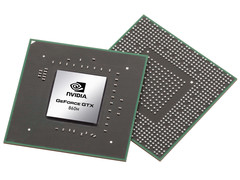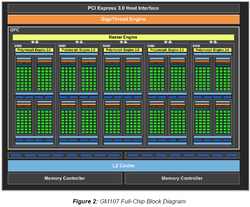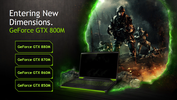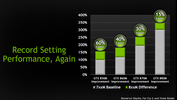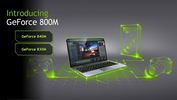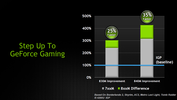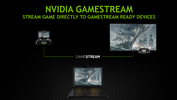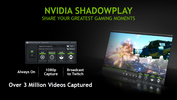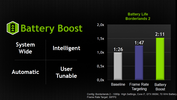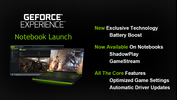It has been almost two years now since Nvidia introduced the latest new chip generation with the Kepler architecture. There have been no big performance or efficiency gains since then. While several models including the former GeForce GT 650M (GK107) have been launched in the meantime with slightly higher clock rates, the core architecture has remained the same.
This has changed with the introduction of the GeForce 800M series. For the first time in a long while, there is a completely new GPU architecture called Maxwell. Its first offspring is the GM107 chip. It is similar to the GeForce GTX 750 and 750 Ti desktop models and stands out with its significantly improved energy efficiency. It's especially impressive that Nvidia does not need a new development process for this. Alike the GK107 and other Kepler models, the GM107 is processed in 28 nm (HP) from TSMC. The finer 20 nm lithography is probably available for bigger mass production later this year and could be used in upcoming Maxwell chips (GM206, GM204, GM200?).
So why is the GM107 so efficient? Two aspects appear to be particularly important: First off all the shader clusters have been greatly revised and feature only 128 instead of 192 ALUs now, which improves efficiency. At the same time, the scheduler has been optimized. So, Maxwell is significantly faster than its predecessor at the same clock rate and shader count. The second important optimization relates to cache and the memory system. In order to get along with the small 128 bit interface, the GM107 uses a 2 MB L2 cache, which should be sufficient for memory accesses. In comparison, Kepler chips must make due with only 256 KB (GK107) and 384 KB (GK106) cache.
| GeForce GTX 880M | GeForce GTX 870M | GeForce GTX 860M | GeForce GTX 850M | GeForce 840M | GeForce 830M | GeForce 820M | |
|---|---|---|---|---|---|---|---|
| Lithography | 28 nm | 28 nm | 28 nm | 28 nm | 28 nm | 28 nm | 28 nm |
| Architecture | Kepler (GK104) | Kepler (GK104) | Maxwell (GM107) / Kepler (GK104) | Maxwell (GM107) | Maxwell (GM108?) | Maxwell (GM108?) | Fermi (GF117) |
| ALUs | 1536 | 1344 | 640 / 1152 | 640 | 384 (?) | 256 (?) | 96 |
| Core clock | 954 MHz + Boost | 941 MHz + Boost | 1029 / 797 MHz + Boost | 876 MHz + Boost | 1.029 MHz + Boost (?) | ? | 775 MHz + Boost |
| Memory interface | 256 Bit (GDDR5) | 192 Bit (GDDR5) | 128 Bit (GDDR5) | 128 Bit (GDDR5) | 64 Bit (DDR3) | 64 Bit (DDR3) | 64 Bit (DDR3) |
| Memory capacity | up to 4 GB | up to 3 GB | up to 2 GB | up to 2 GB | up to 2 GB | up to 2 GB | up to 2 GB |
| Memory clock (eff.) | 1250 MHz (5000 MHz) | 1250 MHz (5000 MHz) | 1250 MHz (5000 MHz) | 1250 MHz (5000 MHz) | 1000 MHz (2.000 MHz) (?) | ? | 900 MHz (1800 MHz) |
But not all new models use Maxwell: As it will take some time before chips faster than the GM107 are available, the GeForce GTX 880M and 870M are still based on Kepler. The same is true for the GeForce 820M low-end model. In addition, there are 860M models that are still based on Kepler. These will most likely be found in notebooks which may also have 870M and 880M options.
At 954 MHz (plus Boost), the GeForce GTX 880M clocks in at more than 15 percent higher than the previous GTX 780M, but is not technically different in any other way. Even if it is to be expected that the average performance gain is below 10 percent, the GTX 880M should still be the fastest mobile GPU. The GTX 870M, whose memory interface (192 instead of 256 bit) as well as shader units (1344 instead of 1536 ALUs) have been slightly cropped, ranks in second. Both models are based on the GK104 chip.
The new mid-range is the GeForce GTX 860M and GTX 850M. Both feature the GM 107 Maxwell chip, which provides 640 shader units, 40 TMUs and 16 ROPs on a 128 bit interface. The core clock rate is the only difference between the two models. The 860M is significantly faster as shown in our first tests (German) where the GTX 860M competes against the GeForce GTX 770M while maintaining lower power consumption. Please note: According to Nvidia a similarly fast, yet probably less efficient Kepler model could be offered in the future.
We can only report few details about the coming entry-level and mid-range models. The GeForce 840M and 830M are also classified as Maxwell models, but they only feature a 64 bit DDR3 memory interface. While further technical information is not available as of this writing, rumors hint at a GM108 chip, which presumably features fewer processing units (3 Cluster, 384 ALUs, 24 TMUs, 8 ROPs). The GeForce 820M is an absolute low-end model and performs even worse. It will still use the Fermi architecture (GF117) and will be very similar to the old GeForce GT 720M.
Finally, we will briefly describe the new features of the 800M series. Let's get one thing straight right away: DirectX 11.2 will still only be supported with feature level 11.0; AMD's GCN architecture (11.2 tier 1 / tier 2) and even Intel's Haswell GPU (11.1) are more advanced here. In addition, HDMI 2.0 is unfortunately not supported.
However, Battery Boost, which should increase battery life during gaming, could be an interesting innovation for notebook gamers. With this technology, which should be launched together with a GeForce Experience update in the coming weeks, slightly decreases the visual detail of games and limits the frame rate to a requested maximum. As a result, the hardware load falls and games can be enjoyed for longer periods of time.
Shadowplay, which allows (like Fraps) video recording on the hard drive, is also new. Nvidia promises high-end real-time encoding in H.264 format with only a small performance loss. If you want, you can even stream your game play live on Twitch.
Streaming is also the key word of the third new feature called Gamestream. It allows rendering games on a notebook with a Kepler or Maxwell GPU and streaming them to Nvidia's handheld console shield via WLAN. Alike Shadowplay and Battery Boost, only the faster GTX models will initially feature Gamestream.
Notebooks with graphics cards from the GeForce 800M series will be available starting today. Apart from the Schenker XMG P304 that we have already reviewed, Nvidia lists among others Asus (G750JZ), Gigabyte (P34R, P34J, P35R), Lenovo (Y50) and MSI (GT60, GT70, GS60, GS70) as launch partners; many other manufacturers should follow in the coming weeks and months.
Source(s)
Own (Nvidia)




